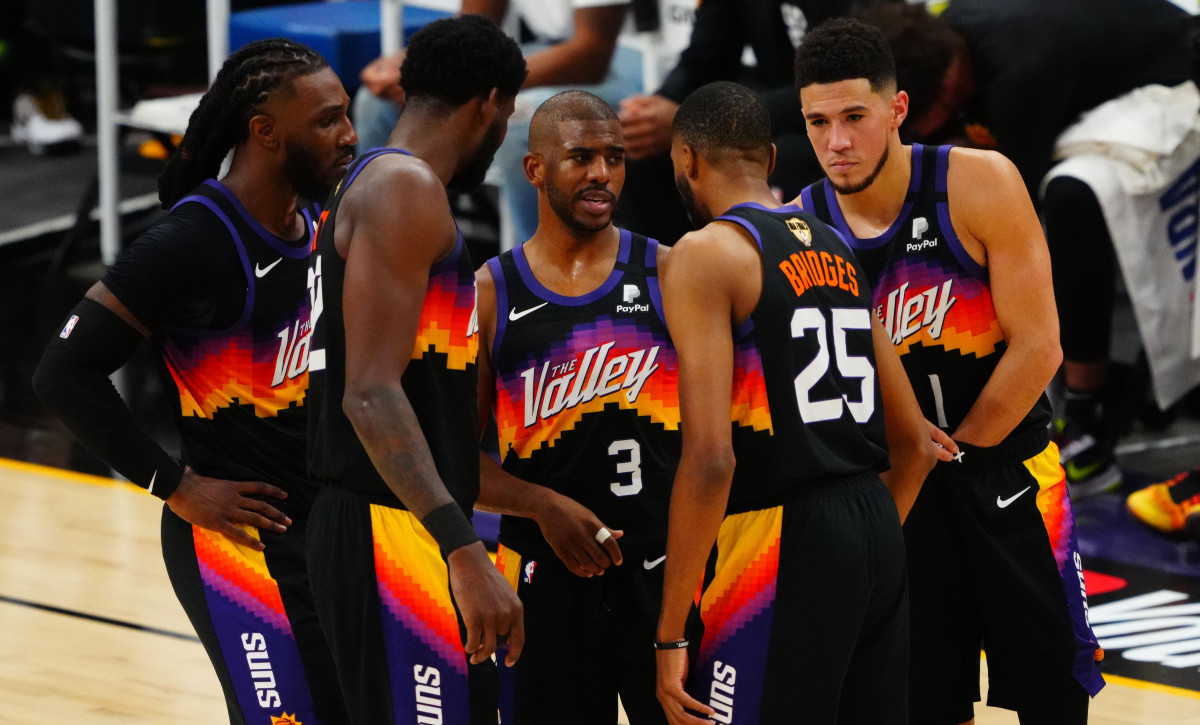Suns' Synergy in Its Starting Unit Propels Finals Run

In a year full of disruption and irregularity, it might not be a coincidence to see the NBA’s most resourceful and frequently used five-man unit flourish in the Finals. During the regular season, Chris Paul, Devin Booker, Mikal Bridges, Jae Crowder and Deandre Ayton appeared in a league-high 52 games (seven more than any other unit) with a league-high 706 minutes (50 more than the runner-up: the Sixers' starting lineup—which was eventually done in by Danny Green’s strained calf).
That volume has stretched into the playoffs, where even through Paul’s injured shoulder and positive COVID-19 test, Phoenix’s starting five has still tallied 84 more minutes and 225 more points than any other group. They’re also first in fourth-quarter minutes (43) and were +40 in the second round (better than any other five-man unit in the semifinals). They haven’t been infallible, getting outscored by 30 points in the conference finals and closing the fourth quarter of that series’ Game 6 with Torrey Craig instead of Bridges.

But in Game 1 of the Finals, the Suns’ starters exploded in 23 excellent minutes—no other troupe logged more than five—with a plus-33.5 net rating that featured smothering defense and an attack the Bucks had no answer for. In the third quarter, coach Monty Williams extended them for the longest stint they’ve ever played, a 10-minute run where the Suns outscored the Bucks by 12 points and blew up the lead to 19. When Milwaukee roared back with Giannis Antetokounmpo at center, Phoenix secured the series-opening victory in its final few minutes with their starters on the floor.
At this point, success for Phoenix’s most common unit should be expected, even if its road here hasn’t been the smoothest one. As other teams—the Clippers, Mavericks, Bucks and Hawks, to name a few—felt an understandable need (for a variety of reasons) to tweak their starters from game to game and matchup to matchup, the Suns haven’t spent much time searching for answers. It’s not that Phoenix’s coaching staff has a rigid belief system or doesn’t value adjustments, but patience is allowed when a fivesome can simultaneously solve and create problems while lifting one another up in ways both dazzling and subtle. That’s exactly what these Suns do.
It’s obvious now after watching them coalesce into such an organized amalgamation, but look back at earlier parts of this season and their success was anything but a guarantee. In early January, Williams switched things up by replacing Crowder with Cam Johnson. The Suns were 7–4 at the time, but that starting five didn’t click right away, with a net rating that sat at a paltry minus-6.5 points per 100 possessions.
Soon enough, massive opposing frontcourts convinced Williams that he needed to beef up his own rotation by replacing Johnson with Frank Kaminsky. At the time, Williams said “there may be some lineups out there on the floor that may not look like something we’ve done before, but the idea is try to match up well against a group that could beat you if you don’t make the right decisions.”
In the middle of March, Phoenix settled back into a starting five that pitted Crowder as a stretch four able to create some matchup problems on both ends. They went 15–4 over the next month, and in a league-high 345 minutes Phoenix's starting five paraded around with the NBA’s best offense and defense. After that run, Crowder missed eight games with a sprained ankle but returned in May. The Suns haven’t looked back since.
On paper, this unit should be dominant. It has everything and more: size, length, ingenuity, tons of space and two ruthless shotmakers who are enhanced by everyone else’s selflessness. One truncated season into their emergence, all five have embraced roles that allow one another to thrive. Two quick examples are Ayton’s near-total forfeiture of post touches and Bridges’s thankless albeit critical on-ball defensive responsibility—while sporting a usage rate that’s below Luke Kennard’s. Both Suns are building blocks who have sacrificed (while extension-eligible!) for the good of the team.
Meanwhile, Booker and Paul take deep breaths in a system that pumps plenty of oxygen around the floor, often directly taking advantage of attention the other creates off the bounce.
And yet, thanks to some relative struggles shooting the three-ball, their offensive rating in nongarbage-time minutes is only a point above the league’s average right now. But they’re competent (turnovers are low), simple and calm, consistently reliant on half-court execution (with a pick-and-roll that often has no response beyond crossed fingers) and five individual defenders who either hold their own or punch above their weight.
Despite surrendering a third of their shots at the rim, it’s that side of the ball where this group shines and stabilizes, allowing only 104.7 points per 100 possessions (about 10 below the postseason average, according to Cleaning the Glass). In the half court, they gobble up just about every available rebound and shut the door on second-chance opportunities.
As the Finals move along and the Bucks forage for solutions with their own various lineup combinations, the Suns will in all likelihood continue to embrace the continuity they’ve forged with an unshakeable unit that represents the best of what this team has to offer. There may not be an easier way to explain why they’re just three wins away from the first championship in franchise history. The Suns’ bench has impressed throughout the run, but this starting five is truly what makes them special.
More NBA Playoffs Coverage:
• The Finals Are Mind-Boggling. And Awesome.
• The Bucks Have No Easy Answer for Chris Paul
• Are these Finals an Aberration or the New Normal?
• Chris Paul Led Phoenix to the NBA Finals on His Own Terms
